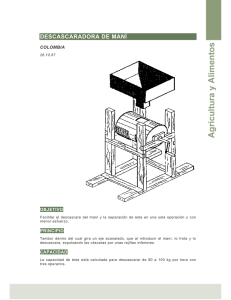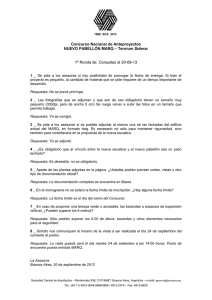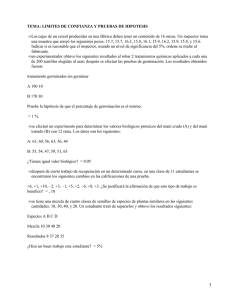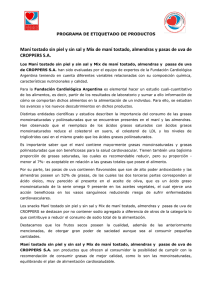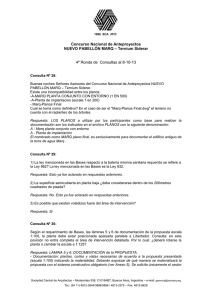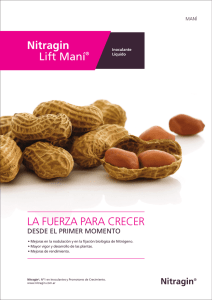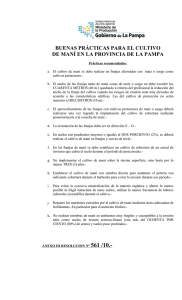MÁQUINA ENFRIADORA ROTATIVA DE MANI TOSTADO, PARA LA
Anuncio
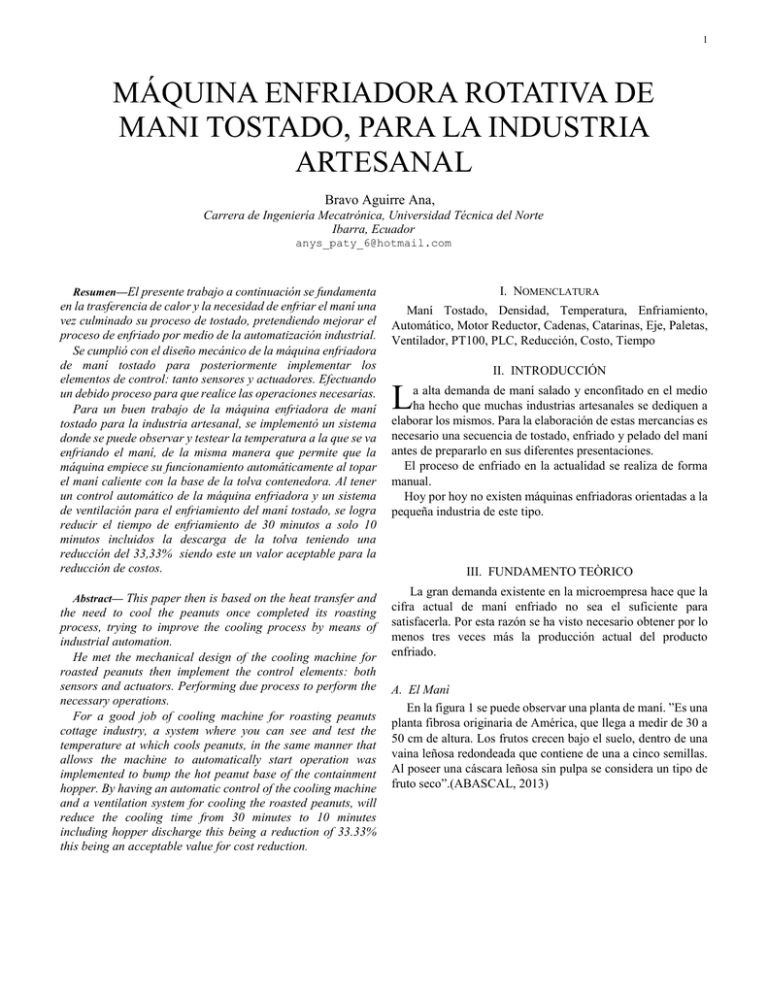
1 MÁQUINA ENFRIADORA ROTATIVA DE MANI TOSTADO, PARA LA INDUSTRIA ARTESANAL Bravo Aguirre Ana, Carrera de Ingeniería Mecatrónica, Universidad Técnica del Norte Ibarra, Ecuador [email protected] Resumen—El presente trabajo a continuación se fundamenta en la trasferencia de calor y la necesidad de enfriar el maní una vez culminado su proceso de tostado, pretendiendo mejorar el proceso de enfriado por medio de la automatización industrial. Se cumplió con el diseño mecánico de la máquina enfriadora de maní tostado para posteriormente implementar los elementos de control: tanto sensores y actuadores. Efectuando un debido proceso para que realice las operaciones necesarias. Para un buen trabajo de la máquina enfriadora de maní tostado para la industria artesanal, se implementó un sistema donde se puede observar y testear la temperatura a la que se va enfriando el maní, de la misma manera que permite que la máquina empiece su funcionamiento automáticamente al topar el maní caliente con la base de la tolva contenedora. Al tener un control automático de la máquina enfriadora y un sistema de ventilación para el enfriamiento del maní tostado, se logra reducir el tiempo de enfriamiento de 30 minutos a solo 10 minutos incluidos la descarga de la tolva teniendo una reducción del 33,33% siendo este un valor aceptable para la reducción de costos. Abstract— This paper then is based on the heat transfer and the need to cool the peanuts once completed its roasting process, trying to improve the cooling process by means of industrial automation. He met the mechanical design of the cooling machine for roasted peanuts then implement the control elements: both sensors and actuators. Performing due process to perform the necessary operations. For a good job of cooling machine for roasting peanuts cottage industry, a system where you can see and test the temperature at which cools peanuts, in the same manner that allows the machine to automatically start operation was implemented to bump the hot peanut base of the containment hopper. By having an automatic control of the cooling machine and a ventilation system for cooling the roasted peanuts, will reduce the cooling time from 30 minutes to 10 minutes including hopper discharge this being a reduction of 33.33% this being an acceptable value for cost reduction. I. NOMENCLATURA Maní Tostado, Densidad, Temperatura, Enfriamiento, Automático, Motor Reductor, Cadenas, Catarinas, Eje, Paletas, Ventilador, PT100, PLC, Reducción, Costo, Tiempo II. INTRODUCCIÓN L a alta demanda de maní salado y enconfitado en el medio ha hecho que muchas industrias artesanales se dediquen a elaborar los mismos. Para la elaboración de estas mercancías es necesario una secuencia de tostado, enfriado y pelado del maní antes de prepararlo en sus diferentes presentaciones. El proceso de enfriado en la actualidad se realiza de forma manual. Hoy por hoy no existen máquinas enfriadoras orientadas a la pequeña industria de este tipo. III. FUNDAMENTO TEÒRICO La gran demanda existente en la microempresa hace que la cifra actual de maní enfriado no sea el suficiente para satisfacerla. Por esta razón se ha visto necesario obtener por lo menos tres veces más la producción actual del producto enfriado. A. El Manì En la figura 1 se puede observar una planta de maní. ”Es una planta fibrosa originaria de América, que llega a medir de 30 a 50 cm de altura. Los frutos crecen bajo el suelo, dentro de una vaina leñosa redondeada que contiene de una a cinco semillas. Al poseer una cáscara leñosa sin pulpa se considera un tipo de fruto seco”.(ABASCAL, 2013) 2 Fig. 1 Planta de maní Fuente:(INFOAGRO, 2013) http://eco.wiz.unikassel.de/ - http://www.pmnh.gov.pk/. B. Propiedades Físicas del Maní En la tabla 1 se indican los datos de la densidad aparente del maní, expresada en kilogramos por metro cubico (kg/m³); estos datos serán utilizados en los próximos capítulos para los cálculos de dimensionamiento y diseño de la MAQUINA ENFRIADORA ROTATVA DE MANI TOSTADO, PARA LA INDUSTRIA ARTESANAL TABLA I DENSIDAD APARENTE DEL MANÌ DENSIDAD APARENTE PRODUCTOS AGRICOLAS SOLIDOS MANÍ CON CÁSCARA PARA DENSIDAD (KG/M3) 370 - 400 ACEITE MANÍ SIN CASCARA 600 - 620 MANÍ CON CÁSCARA PARA 270 - 300 CONSUMO DIRECTO Fuente:(FAO,2013)http://www.fao.org/docrep/x5041s/x50 41s09.htm C. Proceso de Enfriado del Maní Tostado El proceso de enfriamiento del maní tostado se realiza de manera tradicional, esto consiste en dejar enfriar a temperatura ambiente dentro de un envase de madera llamado batan, recipiente que en su base tiene varias perforaciones para permitir el paso de aire frío. Una vez frío el maní se procede a refregarlo y a ventilarlo, es decir, colocar el maní en una tela grande para luego proceder a soplar para eliminar las cortezas del mismo. En La figura 2 se observa el procedimiento tradicional del enfriamiento del maní tostado y la limpieza de cortezas. Cabe recalcar que este procedimiento lleva alrededor de 60 a 90 minutos por ración de 50 libras, dependiendo de la temperatura ambiente. Fig. 2 Enfriamiento del maní al medio ambiente Fuente:http://articulo.mercadolibre.com.ec/MEC402979279-mani-tostado-crudo-en-cantidades-industriales_JM IV. DESCRIPCION DE LA MAQUINA A. Descripción de Construcción de la Máquina Enfriadora Rotativa. La máquina propuesta constará de una tolva, peinetas, un motor reductor, un ventilador, una compuerta, una PT100, un sensor de magnético, un sistema electrónico y de control, y un tablero de control para el operador. La máquina enfriadora rotativa tendrá una capacidad de enfriar cincuenta libras de maní tostado que se depositarán sobre la tolva de la cual dispone. El maní tostado cae directamente sobre la tolva y el operario enciende la máquina para activar así el motor y la caja reductora, con lo obtenemos el movimiento de las paletas para remover el maní en la bandeja. Para acelerar el enfriamiento se enciende un ventilador. Durante el proceso de enfriamiento se monitorea la temperatura con la ayuda de una Pt100, que cuando detecta que la temperatura ha disminuido entre 18 y 20 grados centígrados hace que los indicadores visuales y auditivos se enciendan, de esta forma da aviso al obrero que el maní tostado esta frío. Culminado este proceso, el operario abre la compuerta ubicada en la base de la tolva manualmente y el maní es evacuado fuera de ella con la ayuda de las paletas motrices; al mismo tiempo el ventilador se apaga para ahorrar el consumo de energía durante el proceso de evacuación. Para seguridad, la máquina cuenta con un sensor que mientras la compuerta está abierta, la máquina no se acciona el motoreductor. La figura 3 muestra el diagrama general del funcionamiento con el cual se elaborara la máquina enfriadora de maní tostado. Fig. 3 DIAGRAMA GENERAL Fuente: Ana Bravo 3 V. CÁLCULOS Y DIMENSIONAMIENTO A. Cálculo de las partes de la tolva Para el cálculo del volumen de un sólido se utiliza la ecuación 1. (Shackelford, 2008) 𝑉𝑡 = 𝑚 Ecuación 1 Volumen de un sólido 𝐷 dónde: 𝑉𝑡, el volumen total; 𝑚, la masa del producto; 𝐷, la densidad del producto; Se tiene la densidad del maní con cáscara que es 600 kg/m3; con el cual fácilmente podemos calcular el volumen de la tolva a diseñar. Este dato se toma para cálculos como densidad de un sólido. Como dato adicional se tiene que actualmente la microempresa necesita una producción de 22.7kg/h incluido los procesos de tostado y pelado del maní; lo cual nos indica que la capacidad de peso para aplicar en la tolva es de 22.7Kg; sobredimensionando podemos darle una capacidad de 25kg. Entonces se reemplaza: 𝑚= 25kg 𝐷= 600 kg/m3 25𝑘𝑔 𝑉𝑡 = 600 𝑘𝑔/ 𝑚3 = 0,0416 𝑚3 𝑉𝑡 = 0,0416𝑚3 = 4160cm3 Se continúa con los cálculos del diámetro de la tolva para ello ya se cuenta con el volumen de la misma, utilizamos la ecuación 2 para partir de ella y encontrar el radio y la altura necesarios. Se tiene que 𝑉 = 𝜋𝑟 2 . ℎ Se procede a realizar el mismo procedimiento para los demás datos y se obtienen los resultados de la tabla 2 TABLA II Radios y alturas de la tolva N h (m) r (m) 1 0,18 0,36 2 0,20 0,34 3 0,22 0,33 4 0,24 0,31 5 0,26 0,30 6 0,28 0,29 Fuente: Ana Bravo El valor seleccionado para los cálculos es de 0,36m de radio y 0,18m de altura. B. Dimensionamiento de la Cadena y Catarinas para la Transmisión En el caso más simple, una transmisión por cadena consta de una cadena y dos ruedas de estrella o catarina: una conductora o motriz y otra conducida. Figura 4 Ecuación 2 Volumen de un cilindro Dónde: 𝑉, el volumen total; 𝑟, el radio ℎ, la altura; Se debe considerar alturas aleatorias entre 18cm y 28cm, con un aumento de 2 cifras a partir de la menor, para el cálculo más óptimo del radio, analizando cual es de mayor conveniencia; esto quiere decir que permite que el maní no se riegue ni sobre salga de la tolva además que no se aglomere. Al despejar la ecuación anterior queda la ecuación 3, utilizada para el cálculo del radio de la base de la tolva: 𝑉 r = √𝜋ℎ Ecuación 3 Radio de un cilindro Para los cálculos pertinentes se tiene V= 0,0416𝑚3 Fig. 1 Esquema del Sistema de transmisión Fuente: (CNICE, 2006) http://concurso.cnice.mec.es/cnice2006/material107/mecanism os/mec_cadena-pinon.htm Para seleccionar las catarinas y cadena se considera que: La velocidad de salida del reductor es de 60 rpm La potencia de salida del reductor es de 1Hp Distancia entre centros aproximada 20cm=7,87[pulg] (asumida para que la máquina no sea tan voluminosa) Se toma el primer dato de la altura 0,0416𝑚3 0,0416 r = √3,1416∗0,18 𝑚 = √ 0,565 = √0.130𝑚2 = 0,36𝑚 ; Según los cálculos obtenidos, el sistema de transmisión por cadenas cumple con los parámetros o recomendaciones de diseño, los mimos que se resumen en la tabla 3 4 TABLA III Resumen del diseño de Cadenas y Catarinas PARÁMETRO Paso: Longitud: Distancia entre centros: Catarinas: Catarina Motriz: Catarina conducida: DESCRIPCIÓN Cadena ANSI 60, ¾ de pulgada de paso 1270 mm C= 7, 98 [pulg] ≈ 20,26[𝑐𝑚] hilera simple, número 60, ¾ de pulgada de paso 19 dientes, 4,55[𝑝𝑢𝑙𝑔] = 𝟏𝟏𝟓, 𝟕𝟓 [𝒎𝒎] 38 dientes, 9,08[𝑝𝑢𝑙𝑔] = 𝟐𝟑𝟎, 𝟔𝟗[𝒎𝒎] Fuente: Ana Bravo Diámetro Diámetro C. Diseño del Eje en el CAD INVENTOR PROFESIONAL Este permite realizar el diseño del eje a partir de las fuerzas que se aplican sobre él. Además permite conocer cuál debe ser el diámetro ideal del eje para que logre soportar dichas fuerzas. En la figura 5 se observa el análisis de deformaciones en el eje (CAD Inventor profesional), una vez analizado los datos. Fig. 6 Análisis de Esfuerzos en el eje Fuente: CAD Inventor profesional Se puede observar el punto del esfuerzo máximo en el eje es 129,6 MPa, este valor aproximado es mayor en decimales al esfuerzo de fluencia de 𝟏𝟐𝟗, 𝟒𝟓𝑴𝑷𝒂 del material la cual indica que el sistema se encuentra en el rango elástico permisible del material. En las figura 7 se observa el esquema de distribución de las fuerzas radiales y los torques que actúan sobre el eje. Fig. 7 Distribución de las fuerzas radiales y torques actuantes sobre el eje Fuente: CAD Inventor profesional Fig. 5 Análisis de Deformaciones en el Eje Fuente: CAD Inventor profesional En la mayor deformación dimensional se produce en la unión del eje con la catarina conducida siendo apenas de 0.01375 mm, al momento de enfriar una carga de 25 kg de maní tostado. En la figura 8 se observa el diagrama de cortes en el plano YZ, lo cual se determina que el valor máximo de la fuerza cortante sobre el eje es de 1204,91N. En la figura 6 se observa el análisis de esfuerzos en el eje (CAD Inventor profesional) Fig. 8 Diagrama de fuerza de corte en el plano YZ Fuente: CAD Inventor profesional 5 En la figura 9 indica el diagrama de los momentos flectores analizados en el plano YZ, lo cual se determina el valor del momento flector máximo sobre el eje el cual es de 46,457N*m. Q02 SALIDA DIGITAL Q03 SALIDA DIGITAL Q04 SALIDA DIGITAL Fig. 9 Diagrama del momento flector en el plano YZ Fuente: CAD Inventor profesional D. Diseño del Circuito de Control Para el diseño de control se tomó en cuenta las variables a controlar y la función de la máquina por lo que se decide utilizar. 2 salidas digitales para controlar motor del ventilador, motor para el giro del cilindro. 3 salidas digitales para alarmas de fallos. 1 entrada analógica para lectura del sensor de temperatura. Pantalla TD de logo para que el operario pueda visualizar el valor de la temperatura, además se visualiza el estado de las variables que controlan la misma así como los fallos y estado de los actuadores, sensores etc. Se utiliza el PLC LOGO 12/24RC que es un controlador compacto y cumple los requerimientos de automatización. En la tabla 4 se observa la distribución de las conexiones a realizarse de las variables a controlar hacia el autómata programable. AN0 TX-RX ENTRADA ANALOGICA COMINICACIONES Activará el ventilador para el enfriamiento Luz indicador de inicio de proceso Luz indicadora del fallo del proceso y alarma sonora (compuerta abierta, no se activa el motor o el ventilador) Se conecta con el sensor PT100 para la adquisición de datos de temperatura Conexión de la pantalla LOGO TD para la visualización de mensajes y menús. Fuente: Ana Bravo E. Diagrama de Bloques del Sistema Para realizar la programación del PLC se procede en primer lugar a desarrollar un diagrama de bloques del sistema que se puede observar en la figura 10 TABLA IV Distribución del PLC Testeo de Temperatura I/O CARACTERITICAS DIGITALES PLC SIEMENS LOGO 12/24RC I00 ENTRADA DIGITAL I01 Q01 ENTRADA DIGITAL SALIDA DIGITAL FUNCION Activará en modo manual el paro de emergencia Verificará si la compuerta de la salida del maní está abierta o cerrada Activará el motor reductor para el movimiento de las paletas Encender el motor que hace girar las paletas y el ventilador enfriador Testeo de Temperatura Parará el ventilador y dará aviso al operario con señalizaciones audiovisuales El operario apagara la máquina Fig.10 Diagrama general de control Fuente: Ana Bravo Como primer punto se realizará un testeo de temperatura con la ayuda de una PT100, enviando una señal al PLC el cual accionará el actuador para proceder al encendido del motor que hará girar las paletas dentro de la tolva, al mismo tiempo que hará que se enciendan el actuador con lo que se accionará al ventilador enfriador. El testeo de temperatura se realizará cada minuto de esta manera una vez que el maní llegue a los 20ºC la PT100 enviará una señal al PLC para que este apague el ventilador y accione los avisos audiovisuales de la máquina, es decir accione la chichara y la luz indicadora de parada, para que el operario proceda a la descarga del maní y luego apagar la máquina. 6 VI. RECONOCIMIENTOS Al Ing. Diego Ortiz Morales por su presencia incondicional, sus relevantes y sabios aportes, criticas, comentarios y sugerencias, por su constante y paciente seguimiento, y por haber compartido de manera generosa su tiempo durante la elaboración de este trabajo. A mis padres Isabel y Jorge que día a día han dedicado su vida para hacer de mí una mujer de bien y responsable; a mi amado esposo Ernesto que con su amor y cariño ha sabido fortalecerme cada día. A mi gran amigo Miguel Rojas, que con sus consejos y enseñanzas me ha guiado durante este tiempo. VII. REFERENCIAS ABASCAL, C. (Enero de 2013). CASA ABASCAL. Obtenido de http://www.casaabascal.com/app/article/572CON_CASCARA.html ALVAREZ, J. (s.f.). SLIDESHARE. Obtenido de http://www.slideshare.net/jalvarez60/las-grandes-propiedadesdel-cacahuate ASOCIART. (FEBRERO de 2013). WWW.ASOCIART.COM.AR. Obtenido de www.asociart.com.ar/triptico_Electrico Budynas R., N. J. (2008). Diseño en Ingeniería Mecánica de Shigle. Mexico. Budynas R., N. J. (2008). Diseño en ingeniería mecánica de Shigley (Octava ed.). CLEMAS. (FEBRERO de 2013). www.tektam.com.mx/. ENGORMIX. (ENERO de 2013). www.engormix.com. Obtenido de http://www.engormix.com/shanghai-zhengchanginternacional-maquinaria-ingenieria-ltd/enfriador-linea-sklnsh13618_pr25842.htm FAO. (ENERO de 2013). ORGANIZACION DE LA NACIONES UNIDAS PARA LA ALIMENTACION Y LA AGRICULTURA. Obtenido de http://www.fao.org/docrep/x5027s/x5027S0f.htm Hibbeler, R. (1996). Ingeniería Mecánica, Estática. México: Pearson Educación. INFOAGRO. (FEBRERO de 2013). INFOAGRO.COM. Obtenido de http://eco.wiz.uni-kassel.de/ http://www.pmnh.gov.pk/ INGEMECANICA. (2013). www.ingemecanica.com. Obtenido de http://www.ingemecanica.com/tutorialsemanal/tutorialn121.ht ml#seccion4 INNOVA. (ENERO de 2013). www.innova-ing.com. Obtenido de http://www.innova-ing.com/tratamiento-degranos/ver/enfriadores INTERMEC S.A. (2014). LA TRANSMICION DE POTENCIA POR CADENA DE RODILLO. CATÁLOGO INTERMEC, 5. La Industria Alimentaria - Universidad Politécnica de Cataluña. (ENERO de 2013). ben.upc.es. Obtenido de http://ben.upc.es/documents/eso/aliments/html/pescado-6.html Laneros. Copyright. (FEBRERO de 2013). www.educativa.catedu.es. Obtenido de http://educativa.catedu.es/44700165/aula/archivos/repositorio/1000/1 106/html/34_elementos_de_proteccin.html MAQAFE. (ENERO de 2013). MAQAFE. Obtenido de http://www.maqafe.com.mx/Tostadores.htm MAVIMAR. (OCTUBRE de 2012). maquinariasmavimar.blogspot.com. Obtenido de http://maquinariasmavimar.blogspot.com/2010/09/tostadoras.h tml Moth, R. (2006). Diseño de elementos de máquinas. Mott, R. (2006). Mecánica de Fluidos. México: Person Educación. OMEGA. (FEBRERO de 2013). es.omega.com. Obtenido de http://es.omega.com/prodinfo/pt100.html OMRON. (FEBRERO de 2013). www.directindustry.es. Obtenido de http://www.directindustry.es/prod/omron/relespotencia-enclavamientos-polarizados-15954-543783.html PRENSA INTA. (ENERO de 2013). PREGON AGROPECUARIO. Obtenido de http://www.pregonagropecuario.com/cat.php?txt=795 REINASA. (FEBRERO de 2013). WWW.REINASA.COM. Obtenido de http://www.reinasa.com/cajas.html RIBA, C. (2002). Diseño Concurrente (Primera ed.). España: Edicions UPC. SABROSITIO. (ENERO de 2013 ). SABROSITIO. Obtenido de http://www.sabrositio.com/receta/mani-confitado Shackelford, J. F. (2008). Introducción a la Ciencia de Materiales para Ingenieros. Shigley, J. (s.f.). Diseño en ingeniería mecánica, (8va Edición ed.). SIEMENS. (2012). Manual de Usuario LOGO TD. SKF. (2010). Catálogo de Selección de Correas. SKF. (2013). Catalogo de selección de rodamientos. SUMITEC S.A. (FEBRERO de 2013). CATALOGO DE ACERO AISI 304. Obtenido de http://www.es.scribd.com/doc/44500095/Existen-Dos-Formasde-Identificar-Los-Aceros Tippens, P. E. (2001). Física, Conceptos y Aplicaciones. México: McGraw - Hill. UNET VENEZUELA. (16 de ENERO de 2013). www.unet.edu.ve. Obtenido de http://www.unet.edu.ve/~maqflu/doc/LAB-1-128.htm WARK, K. (2001). Termodinámica. Madrid, España: McGRAW - HILL. VIII. BIOGRAFÍA Ana Patricia Bravo Aguirre nacida en San Roque, cantón Antonio Ante, provincia de Imbabura, el 27 de octubre de 1985. Egresada de la Carrera de ingeniería Mecatrónica de la Universidad Técnica del Norte de la ciudad de Ibarra. 7 MÁQUINA ENFRIADORA ROTATIVA DE MANI TOSTADO, PARA LA INDUSTRIA ARTESANAL Bravo Aguirre Ana, Carrera de Ingeniería Mecatrónica, Universidad Técnica del Norte Ibarra, Ecuador [email protected] Abstract— This paper then is based on the heat transfer and the need to cool the peanuts once completed its roasting process, trying to improve the cooling process by means of industrial automation. He met the mechanical design of the cooling machine for roasted peanuts then implement the control elements: both sensors and actuators. Performing due process to perform the necessary operations. For a good job of cooling machine for roasting peanuts cottage industry, a system where you can see and test the temperature at which cools peanuts, in the same manner that allows the machine to automatically start operation was implemented to bump the hot peanut base of the containment hopper. By having an automatic control of the cooling machine and a ventilation system for cooling the roasted peanuts, will reduce the cooling time from 30 minutes to 10 minutes including hopper discharge this being a reduction of 33.33% this being an acceptable value for cost reduction. I. NOMENCLATURE Roasted Peanuts, Density, Temperature, Cool, Auto, Motor Reducer, Chains, Sprockets, Axle Paddle, Fan, PT100, PLC, Reduction, Cost, Time II. INTRODUCTION H igh demand for salted peanuts and enconfitado in the middle has made many cottage industries engaged in developing them. For the production of these goods a sequence of roasted, cooled and peeled before cooking peanuts in different presentations necessary. The cooling process is currently done manually. Today there are no chillers oriented small industry of this type. III. RATIONALE The great demand in microenterprise makes peanut cooled current figure is not enough to satisfy her. For this reason it has been necessary to obtain at least three times the current production of the cooled product. A. The Peanuts Figure 1 shows a plant with peanuts. "It is a fibrous plant native to America, which grows to 30-50 cm tall. The fruits grow underground, within a rounded woody pod containing one to five seeds. Possessing a woody shell without pulp is considered a type of nut. "(ABASCAL, 2013) Fig. 1 Peanut Plant Source:(INFOAGRO, 2013) http://eco.wiz.uni-kassel.de/ http://www.pmnh.gov.pk/. B. . Physical Properties of Peanuts Table 1 details the apparent density of the peanut, in kilograms per cubic meter (kg / m³) are indicated; these data will be used in later chapters for sizing calculations and design MAQUINA ENFRIADORA ROTATVA DE MANI TOSTADO, PARA LA INDUSTRIA ARTESANAL TABLE I DENSITY PEANUT DENSITY AGRICULTURAL PRODUCTS SOLID PEANUT IN SHELL OIL SOLID DENSITY (KG/M3) 370 - 400 PEANUT SHELL WITHOUT 600 - 620 PEANUT IN SHELL FOR DIRECT CONSUMPTION 270 - 300 Source::(FAO,2013)http://www.fao.org/docrep/x5041s/x504 1s09.htm 8 C. Process Cooling of Roasted Peanuts The cooling of roasted peanuts is done the traditional way, this is to let cool to room temperature inside a wooden container called churn, container at its base has several holes to allow the passage of cold air. Once cold peanuts and proceeds to rub it ventilate, ie, place the peanuts in a large cloth and then proceed to blow out to remove the bark thereof. In Figure 2 the traditional method of cooling the roasted peanuts and cleaning shells is observed. It should be noted that this procedure takes about 60 to 90 minutes per serving of 50 pounds, depending on the ambient temperature. Fig. 3 GENERAL DIAGRAM Source: Ana Bravo V. CALCULATIONS AND SIZING A. Calculation of the parts of the Hopper To calculate the volume of a solid using equation 1. (Shackelford, 2008) 𝑚 𝑉𝑡 = 𝐷 Equation 4 Volume of a solid Fig. 2 Chill peanut environmental Source:http://articulo.mercadolibre.com.ec/MEC402979279-mani-tostado-crudo-en-cantidades-industriales_JM IV. DESCRIPTION OF THE MACHINE A. Description of Construction Machine Rotary Chiller. The proposal will consist of a hopper machine, hair combs, gear motor, a fan, a gate, PT100, magnetic sensor, an electronic control system, and a control panel for the operator. The rotary machine chiller cooling capacity will be fifty pounds of roasted peanuts to be deposited into the hopper which has. The roasted peanuts falling directly on the hopper and the operator turns on the machine and activate the motor and gearbox, so we obtain the movement of the blades to remove the peanut tray. To speed cooling fan is turned on. During the cooling process the temperature is monitored with the help of a Pt100, which detects when the temperature has decreased between 18 and 20 degrees centigrade makes visual and auditory indicators light, thus gives the worker notice that peanuts toast is cold. Completed this process, the operator opens the gate at the base of the hopper manually and peanuts is evacuated out of it with the help of motor vanes; while the fan turns off to conserve energy during the evacuation process. For safety, the machine has a sensor while the gate is open, the machine does the geared motor is operated. Figure 3 shows the general diagram of the operation to which the chiller machine roasted peanuts was developed. where: 𝑉𝑡, total volume; 𝑚, product mass; 𝐷, product density; It has the density of the peanut shell is 600 kg/m3; with which we can easily calculate the volume of the hopper design. This data is taken for calculations such as density of a solid. As additional data must be currently microenterprise production needs 22.7kg / h inclusive processes peanuts roasted and peeled; which indicates that the weight capacity to implement in the hopper is 22.7kg; I can give you exaggerating a capacity of 25kg. Then it replaces: 𝑚= 25kg 𝐷= 600 kg/m3 25𝑘𝑔 𝑉𝑡 = 600 𝑘𝑔/ 𝑚3 = 0,0416 𝑚3 𝑉𝑡 = 0,0416𝑚3 = 4160cm3 Continue to calculate the diameter of the hopper for it already has the same volume, we use equation 2 to leave her and find the radius and height required. It must: 𝑉 = 𝜋𝑟 2 . ℎ Equation 5 Volume of a cylinder Where: 𝑉, total volume; 𝑟, radius ℎ, height; Consideration should be given random heights between 18cm and 28cm, with an increase of 2 digits from the least to the best estimate of the radius, which is analyzing convenience; this means that allows the peanut not be watered or on leaving the hopper also not agglomerate. Solving the above equation is the equation 3 is used to calculate the radius of the base of the hopper: 9 𝑉 r = √𝜋ℎ Equation 6 Radio cylinder For relevant calculations have V= 0,0416𝑚3 To select sprockets and chain is considered that: • The gearbox output speed is 60 rpm • The output of the reducer is 1Hp • Distance between centers approximately 20cm = 7.87 [in] (assumed for the machine is not as bulky) According to the estimates obtained, the chain drive system meets the parameters or design recommendations, pampering summarized in Table 3 The first datum height is taken TABLE III 0,0416𝑚3 0,0416 r = √3,1416∗0,18 𝑚 = √ 0,565 = √0.130𝑚2 = 0,36𝑚 ; The procedure to perform the same procedure for the other data and the results in Table 2 are obtained TABLE II Radio and heights of the hopper N h (m) r (m) 1 0,18 0,36 2 0,20 0,34 3 0,22 0,33 4 0,24 0,31 5 0,26 0,30 6 0,28 0,29 Source: Ana Bravo The value selected for the calculations is 0.36 m radius and 0.18 m high. Abstract Design Chains and Sprockets PARAMETER Paso: Longitud: Distancia entre centros: Catarinas: Catarina Motriz: Catarina conducida: DESCRIPTION Cadena ANSI 60, ¾ de pulgada de paso 1270 mm C= 7, 98 [pulg] ≈ 20,26[𝑐𝑚] hilera simple, número 60, ¾ de pulgada de paso 19 dientes, 4,55[𝑝𝑢𝑙𝑔] = 𝟏𝟏𝟓, 𝟕𝟓 [𝒎𝒎] 38 dientes, 9,08[𝑝𝑢𝑙𝑔] = 𝟐𝟑𝟎, 𝟔𝟗[𝒎𝒎] Source: Ana Bravo Diámetro Diámetro C. Axis Design in CAD INVENTOR PROFESSIONAL This allows the shaft design from the forces applied on it. It reveals what should be the ideal diameter of the shaft to achieve withstand these forces. Figure 5 shows the analysis of the deformation of the shaft (CAD Inventor Professional) is observed after analyzing the data. B. Sizing Chain and Sprockets for Transmission In the simplest case, a chain drive consists of a chain and two sprockets or sprocket: a conductive or motor driven and over. Figure 4 Fig. 5 Deformation Analysis on Axis Source: CAD Inventor profesional Fig. 2 Outline Transmission System Source:(CNICE, 2006) http://concurso.cnice.mec.es/cnice2006/material107/mecanism os/mec_cadena-pinon.htm In most dimensional deformation occurs at the junction of the shaft with the driven sprocket being just 0.01375 mm, when cooling a load of 25 kg of roasted peanuts. 10 In Figure 6 the analysis of stress is observed in the shaft (CAD professional Inventor) Figure 9 shows the diagram of bending moments analyzed in the YZ plane, which the value of the maximum bending moment on the shaft which is 46,457 N * m is determined. Fig. 9 Bending moment diagram in the YZ plane Source: CAD Inventor profesional Fig. 6 Análisis de Esfuerzos en el eje Source: CAD Inventor profesional One can observe the point of maximum stress in the axle is 129.6 MPa, this approximate decimal value is higher than the yield stress of the material 129,45 MPa which indicates that the system is in the allowable range of the elastic material. The distribution pattern of the radial forces and torques acting on the axis is seen in Figure 7. D. Control Circuit Design For control design took into account the control variables and the function of the machine so you decide to use. 2 digital outputs to control fan motor, motor for rotating the cylinder. 3 digital outputs for fault alarms. 1 analog input for temperature sensor reading. TD logo screen for the operator to display the temperature value, plus the state of the variables that control the same and state faults and actuators, sensors, etc. is displayed. 12/24RC LOGO PLC is a compact controller and meets the requirements of automation is used. Table 4 shows the distribution of observed connections to be made of the control variables to the PLC. TABLE IV PLC distribution Fig. 7 Distribution of the radial forces and torques acting on the axle Source: CAD Inventor profesional In Figure 8, the cutting pattern in the YZ plane is observed, which is determined that the maximum value of the shear force on the shaft is of 1204.91 N. Fig. 8 Diagram of cutting force in the YZ plane Source: CAD Inventor profesional I/O CARACTERITICAS DIGITALES PLC SIEMENS LOGO 12/24RC I00 ENTRADA DIGITAL I01 ENTRADA DIGITAL Q01 SALIDA DIGITAL Q02 SALIDA DIGITAL Q03 SALIDA DIGITAL FUNCION Activará en modo manual el paro de emergencia Verificará si la compuerta de la salida del maní está abierta o cerrada Activará el motor reductor para el movimiento de las paletas Activará el ventilador para el enfriamiento Luz indicador de 11 Q04 AN0 TX-RX SALIDA DIGITAL ENTRADA ANALOGICA COMINICACIONES inicio de proceso Luz indicadora del fallo del proceso y alarma sonora (compuerta abierta, no se activa el motor o el ventilador) Se conecta con el sensor PT100 para la adquisición de datos de temperatura Conexión de la pantalla LOGO TD para la visualización de mensajes y menús. Source: Ana Bravo E. System Block Diagram To program the PLC proceeds first to develop a system block diagram which can be seen in Figure 10 Testeo de Temperatura Encender el motor que hace girar las paletas y el ventilador enfriador Testeo de Temperatura Parará el ventilador y dará aviso al operario con señalizaciones audiovisuales El operario apagara la máquina Fig.10 General diagram control Source: Ana Bravo As a first extent a temperature testing will be performed with the help of a PT100, sending a signal to the PLC which actuate the actuator to proceed to the engine ignition that will turn paddles in the hopper, while it will turn on the actuator which is operated with the cooling fan. The testing temperature every minute in this way will be made once the peanuts reached 20 ° C the PT100 will send a signal to the PLC for this turn off the fan and operate audiovisual warnings of the machine, ie operate the Chichara and light stop indicator for the operator proceed to download peanuts and shut down the machine. VI. AWARDS Ing Diego Ortiz Morales for their unconditional presence, its relevant and wise contributions, criticisms, comments and suggestions, for his constant and patient monitoring, and for generously sharing their time during the preparation of this work. My parents Isabel and Jorge who daily have dedicated their lives to make me a woman of good and responsible; my beloved husband Ernesto with his love and affection every day has managed to strengthen me. To my great friend Miguel Rojas, with advice and teachings have guided me during this time. . VII. REFERENCES ABASCAL, C. (Enero de 2013). CASA ABASCAL. Obtenido de http://www.casaabascal.com/app/article/572CON_CASCARA.html ALVAREZ, J. (s.f.). SLIDESHARE. Obtenido de http://www.slideshare.net/jalvarez60/las-grandes-propiedadesdel-cacahuate ASOCIART. (FEBRERO de 2013). WWW.ASOCIART.COM.AR. Obtenido de www.asociart.com.ar/triptico_Electrico Budynas R., N. J. (2008). Diseño en Ingeniería Mecánica de Shigle. Mexico. Budynas R., N. J. (2008). Diseño en ingeniería mecánica de Shigley (Octava ed.). CLEMAS. (FEBRERO de 2013). www.tektam.com.mx/. ENGORMIX. (ENERO de 2013). www.engormix.com. Obtenido de http://www.engormix.com/shanghai-zhengchanginternacional-maquinaria-ingenieria-ltd/enfriador-linea-sklnsh13618_pr25842.htm FAO. (ENERO de 2013). ORGANIZACION DE LA NACIONES UNIDAS PARA LA ALIMENTACION Y LA AGRICULTURA. Obtenido de http://www.fao.org/docrep/x5027s/x5027S0f.htm Hibbeler, R. (1996). Ingeniería Mecánica, Estática. México: Pearson Educación. INFOAGRO. (FEBRERO de 2013). INFOAGRO.COM. Obtenido de http://eco.wiz.uni-kassel.de/ http://www.pmnh.gov.pk/ INGEMECANICA. (2013). www.ingemecanica.com. Obtenido de http://www.ingemecanica.com/tutorialsemanal/tutorialn121.ht ml#seccion4 INNOVA. (ENERO de 2013). www.innova-ing.com. Obtenido de http://www.innova-ing.com/tratamiento-degranos/ver/enfriadores INTERMEC S.A. (2014). LA TRANSMICION DE POTENCIA POR CADENA DE RODILLO. CATÁLOGO INTERMEC, 5. La Industria Alimentaria - Universidad Politécnica de Cataluña. (ENERO de 2013). ben.upc.es. Obtenido de http://ben.upc.es/documents/eso/aliments/html/pescado-6.html Laneros. Copyright. (FEBRERO de 2013). www.educativa.catedu.es. Obtenido de http://educativa.catedu.es/44700165/aula/archivos/repositorio/1000/1 106/html/34_elementos_de_proteccin.html MAQAFE. (ENERO de 2013). MAQAFE. Obtenido de http://www.maqafe.com.mx/Tostadores.htm MAVIMAR. (OCTUBRE de 2012). maquinariasmavimar.blogspot.com. Obtenido de 12 http://maquinariasmavimar.blogspot.com/2010/09/tostadoras.h tml Moth, R. (2006). Diseño de elementos de máquinas. Mott, R. (2006). Mecánica de Fluidos. México: Person Educación. OMEGA. (FEBRERO de 2013). es.omega.com. Obtenido de http://es.omega.com/prodinfo/pt100.html OMRON. (FEBRERO de 2013). www.directindustry.es. Obtenido de http://www.directindustry.es/prod/omron/relespotencia-enclavamientos-polarizados-15954-543783.html PRENSA INTA. (ENERO de 2013). PREGON AGROPECUARIO. Obtenido de http://www.pregonagropecuario.com/cat.php?txt=795 REINASA. (FEBRERO de 2013). WWW.REINASA.COM. Obtenido de http://www.reinasa.com/cajas.html RIBA, C. (2002). Diseño Concurrente (Primera ed.). España: Edicions UPC. SABROSITIO. (ENERO de 2013 ). SABROSITIO. Obtenido de http://www.sabrositio.com/receta/mani-confitado Shackelford, J. F. (2008). Introducción a la Ciencia de Materiales para Ingenieros. Shigley, J. (s.f.). Diseño en ingeniería mecánica, (8va Edición ed.). SIEMENS. (2012). Manual de Usuario LOGO TD. SKF. (2010). Catálogo de Selección de Correas. SKF. (2013). Catalogo de selección de rodamientos. SUMITEC S.A. (FEBRERO de 2013). CATALOGO DE ACERO AISI 304. Obtenido de http://www.es.scribd.com/doc/44500095/Existen-Dos-Formasde-Identificar-Los-Aceros Tippens, P. E. (2001). Física, Conceptos y Aplicaciones. México: McGraw - Hill. UNET VENEZUELA. (16 de ENERO de 2013). www.unet.edu.ve. Obtenido de http://www.unet.edu.ve/~maqflu/doc/LAB-1-128.htm WARK, K. (2001). Termodinámica. Madrid, España: McGRAW - HILL. VIII. BIOGRAPHY Ana Patricia Aguirre Bravo born in San Roque, Antonio Ante Canton province of Imbabura, on October 27, 1985. Graduated from the School of Mechatronics Engineering, Technical University of Northern Ibarra.
